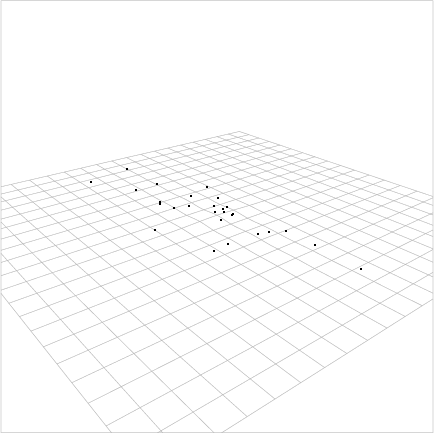Linear algebra underpins STEAM (science, technology, engineering, art, mathematics). At the same time, its ramifications for automated behavior prediction (2013) and manipulation (2017) are profoundly important, and too often wielded for consolidation of wealth and power (2025): At best fraudulently in the names of progress and efficiency; at worst invisibly and illegally; in any case unilaterally, at ubiquitous scale.

Algorithms detect a patterned cloud.
Power exploits the resulting landscape of possibility.
Among the most basic concepts and skills of linear algebra are matrices, systems of linear equations and algorithms for solving, and the geometry of matrix multiplication. These idiomatic elements are roughly analogous to an alphabet and basic vocabulary. Informed understandings of data science, surveillance capitalism, image recognition, machine learning, and other modern technologies have roots in linear algebra. This post showcases four simple interactive programs for low-dimensional linear algebra, and my gratis textbook manuscript for a one-semester linear algebra course.
Matrix Multiplication presents two rectangular arrays and prompts you to multiply them as matrices, with or without hints. Aside from clicking radio buttons, the program can be navigated using only the TAB and RETURN keys.
Row Reduction lets you practice solving a system of linear equations. The program manages the arithmetic, letting you focus on the conceptual strategy of systematically solving for and eliminating variables one by one.
Matrix Inversion uses the row reduction algorithm to invert a square matrix. Again, the program manages the arithmetic, letting you focus on conceptual strategy.
Geometry of Linear Transformations develops the (ultimately simple) bridge between a matrix of real numbers and the geometric effect of matrix multiplication on the plane.
Linear Algebra is a 2015 textbook manuscript for a one-semester course in linear algebra. The preface To the Student uses systems in two variables and plane transformations to encapsulate the book’s material in 8 pages.
At the back end, far from the superficial experience of user interfaces, digital technology is arguably nothing but linear algebra. Sets of data, individual and collective human behaviors, literally have a shape, a geometry, and are consequently more predictable than is comfortable to imagine. Ignoring this, unfortunately, does not stop others from scrutinizing and utilizing ourselves against us.